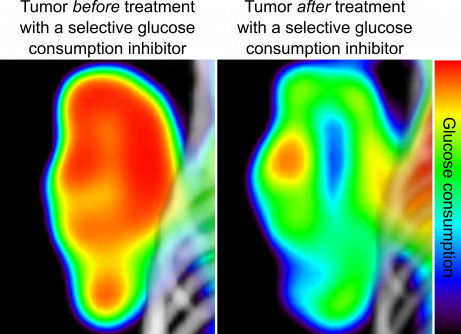UCLA’s New Automated Platform Assist In Identifying Cancer Cell Metabolism Inhibitors
Source: Thailand Medical News Nov 30, 2019 5 years, 4 months, 4 weeks, 2 hours, 49 minutes ago
Researchers from
UCLA Jonsson Comprehensive
Cancer Center have developed a new rapid automated method for testing hundreds of molecules at a time to find out which ones block
cancer cells from consuming
glucose, the sugars they need to spread and grow.
The researchers told
Thailand Medical News that by utilizing robotics, they were able to test 3,555 compounds on non-small-cell lung
cancer cells. They identified 97 molecules that inhibited these
cancer cells from consuming
glucose. In another study, these 97 molecules could be further tested to see which ones don’t interfere with healthy cell metabolism.
 Before and after: The tumor pictured on the left has metabolized a high amount of glucose, the
Before and after: The tumor pictured on the left has metabolized a high amount of glucose, the
sugar it needs to grow. The same tumor is shown on the right after it has been treated with a
molecule that prevents it from consuming glucose. Credit: UCLA
Typically,
cancer cells need to consume sugar in the form of
glucose to grow and spread. Healthy cells also need sugar to carry out their normal cellular functions, such as creating energy for the body. Researchers have known for a long time that preventing
cancer cells from consuming
glucose will cause them to stop growing as quickly and make them easier to treat.
But the challenge has been developing and identifying targeted therapies that are able to prevent
cancer cells from consuming
glucose while not interfering with the metabolism of healthy cells.
Currently, testing drugs that keep
cancer cells from consuming
glucose is a slow process because only one or two therapies are screened at a time. To change this,
UCLA researchers have developed an automated technique using robotics that can test the effects of hundreds of molecules on non-small-cell lung
cancer tumors at one time.
With the new platform in the
UCLA Molecular Screening Shared Resource facility designed to test molecules against biological targets such as
cancer cells, the researchers used a special
glucose analogue that mimics naturally occurring glucose and rectangular plates with 384 individual wells for the test.
The medical researchers put non-small-cell lung
cancer cells into each of the wells in the rectangular plates. They also put a different compound into each of the wells with the
cancer cells. These compounds were given time to affect the
cancer cells.
After this, a
glucose analogue was introduced into the cells, which the cells metabolized. The researchers treated the cells with a set of enzymes that use the metabolized
glucose
analogue to produce bioluminescence, or a light that can be tracked.
Utilizing a plate reader that is able to track the amount of light that comes out of each well, the researchers recorded how much of the
glucose molecule the tumors in each of the wells were able to metabolize.
The new automated method will speed up how researchers test for therapies that block the metabolism of non-small-cell lung
cancer tumors. In the future, this method may also be used to test for molecules that are able to inhibit the metabolism of other types of
cancer cells.
Reference: Ghezzi, C., Wong, A., Chen, B.Y. et al. A high-throughput screen identifies that CDK7 activates glucose consumption in lung cancer cells. Nat Commun 10, 5444 (2019) doi:10.1038/s41467-019-13334-8 Published 29 November 2019 DOI https://doi.org/10.1038/s41467-019-13334-8 